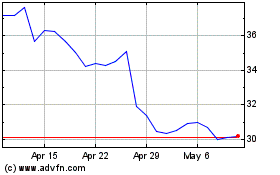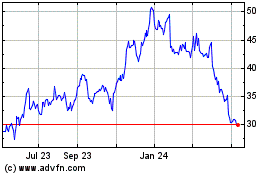By Asa Fitch
A U.S.-born approach to defining how computer processors work
presents a potential steppingstone to chip independence for Chinese
tech companies that face growing limits from Washington on buying
American semiconductors.
The so-called RISC-V technology offers an openly accessible
approach to running the brains that power personal computers,
smartphones and servers. It is an emerging rival to two,
long-dominant proprietary models from Intel Corp. and Arm Holdings
Ltd., a British company that U.S. graphics-chip maker Nvidia Inc.
agreed in September to acquire for $40 billion.
The standard is winning global interest, and early users include
Chinese online retail and tech giant Alibaba Group Holding Ltd.,
which developed what some industry insiders consider the
highest-performance RISC-V chip in production. Alibaba has said it
is using that chip in its data centers to perform artificial
intelligence calculations, and is selling versions of it.
Widespread adoption of RISC-V, pronounced "risk five," could
open the door for China to accelerate efforts to end its dependence
on Western chip technology, threaten licensing revenues for Arm and
could aid the rise of new rivals to incumbent chip makers, industry
executives and analysts said.
"China wants to have its own architecture, but also an
architecture where license fees won't have to be paid. So we see a
strong buildup of RISC-V in China," said Handel Jones, the chief
executive of International Business Strategies Inc., an industry
consulting and analysis firm.
Chip architectures like RISC-V provide a sort of language for
translating software commands into instructions for processors to
perform the computations needed to send email, play games or
perform other tasks. Those base-level instructions have been
largely defined by Intel, whose x86-based chips dominate personal
computers and servers, and Arm, which dominates smartphones and
other portable devices by licensing its architecture to companies
such as Apple Inc. that add their own modifications.
RISC-V is open-sourced, meaning its technical details are public
and changes are openly debated. The technology remains far behind
in performance to what Intel and Arm currently offer; Alibaba says
its chip is comparable to that of a mobile-phone processor from
several years ago. However, the standard's backers -- which include
prominent researchers and major companies in the U.S. -- hope it
will do for hardware what the open-source movement did for
software, shifting power from big incumbents and democratizing the
plumbing of modern computing.
"People are fired by this vision and moving ahead because they
see it as a long-term bet," said David Patterson, one of the
pioneers behind RISC-V. While the technology may not be as mature
as alternatives, he said the possibilities for its growth were
unlimited.
Work on RISC-V, which originated at the University of
California, Berkeley, dates back about a decade, but Nvidia's
landmark acquisition this year and the technological face-off
between China and the U.S. are fueling new interest.
Adoption of the architecture has accelerated. Membership in
RISC-V International, a body that promotes the standard, climbed by
64% last year to more than 750 members, said Calista Redmond, the
group's chief executive. "It's moving from [research and
development] departments into let's go build something for real and
see how it performs."
For China, the technology offers a framework that could help
insulate the country from U.S. export limits. Washington added
Chinese telecom giant Huawei Technologies Co. to an export
blacklist in 2019, and has sought to limit other big Chinese chip
companies including manufacturing giant Semiconductor Manufacturing
International Corp., which was added to the export blacklist in
December. Arm's temporary suspension of its work with Huawei after
the Chinese company's blacklisting by the U.S. further raised the
alarm there.
RISC-V alone wouldn't resolve China's chip reliance on foreign
suppliers. The country is still dependent on other foreign
technologies, including key chip-design software and manufacturing
tools.
Some U.S. officials view China's embrace of the standard with
alarm. RISC-V was developed partly with backing by the Defense
Advanced Research Projects Agency, the Pentagon's research arm, and
was pursued initially as a tool for academics to work on projects
without paying royalties for proprietary systems. As U.S. concerns
about China's technical prowess have grown, some officials worry
Chinese access to the fruits of open-source projects, including
RISC-V, gives it an advantage.
"Am I giving China a leg up on all these technologies because
they can now save 20 years of engineering and catch up to Western
technology overnight? It's not unlikely," said Serge Leef, a Darpa
program manager overseeing semiconductor projects.
RISC-V's backers say that while Chinese adoption has been
strong, the architecture is making rapid inroads in Europe and the
U.S., too, and members in the foundation behind it are about evenly
split between North America, Asia-Pacific and Europe.
The global body overseeing RISC-V relocated last year from the
U.S. to Switzerland. Mr. Patterson, who heads a RISC-V-focused lab
based at Beijing's Tsinghua University, said the move was meant to
address member concerns that their work could be caught up in U.S.
export restrictions, but it wasn't a direct response to the
U.S.-China trade tussle.
Competition among regional governments in China for tech
leadership is propelling RISC-V efforts there, said Alex Guo, a
chip engineer in Shanghai who co-chairs a regional task force for
the RISC-V Foundation. The momentum also is driven by the expense
of Arm licenses and the fact that RISC-V is more easily
configurable because it is open-source, Mr. Guo said.
Arm declined to comment.
Nvidia's planned acquisition of Arm has raised concerns among
industry executives that Nvidia could raise the cost of licensing
Arm technology or interfere in its relationships for competitive
reasons. Nvidia has said it wouldn't do that, but rivals see RISC-V
as insurance.
Mobile-chip giant Qualcomm Inc. and South Korea's Samsung
Electronics Co. have incorporated RISC-V into some of their
flagship chips for smartphones. A large portion of existing
commercial applications for RISC-V so far have been limited to
so-called microcontrollers, embedded in more powerful systems to
perform narrow tasks like routing data from a keyboard.
"We are setting our sights a little bit higher," said Zvonimir
Bandic, a board member of the body overseeing the RISC-V standard
and a senior director at data-storage giant Western Digital Corp.,
which is using RISC-V in chips that handle data going to and from
its drives. The ambition is to have high-end computers using the
standard within around five years.
Write to Asa Fitch at asa.fitch@wsj.com
(END) Dow Jones Newswires
January 11, 2021 09:46 ET (14:46 GMT)
Copyright (c) 2021 Dow Jones & Company, Inc.
Intel (NASDAQ:INTC)
Historical Stock Chart
From Mar 2024 to Apr 2024

Intel (NASDAQ:INTC)
Historical Stock Chart
From Apr 2023 to Apr 2024
